| Srl | Item |
| 1 |
ID:
005004
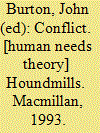

|
|
|
|
|
| Publication |
Houndmills, Macmillan, 1993.
|
| Description |
xxv, 358p.
|
| Standard Number |
033352148X
|
|
|
|
|
|
|
|
|
|
|
|
Copies: C:1/I:0,R:0,Q:0
Circulation
| Accession# | Call# | Current Location | Status | Policy | Location |
| 036072 | 303.69/BUR 036072 | Main | On Shelf | General | |
|
|
|
|
| 2 |
ID:
168638
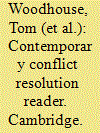

|
|
|
|
|
| Publication |
Cambridge, Polity Press, 2015.
|
| Description |
xxi, 419p.pbk
|
| Standard Number |
9780745686776
|
|
|
|
|
|
|
|
|
|
|
|
Copies: C:1/I:0,R:0,Q:0
Circulation
| Accession# | Call# | Current Location | Status | Policy | Location |
| 059749 | 303.69/WOO 059749 | Main | On Shelf | General | |
|
|
|
|
| 3 |
ID:
110778
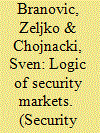

|
|
|
|
|
| Publication |
2011.
|
| Summary/Abstract |
This article presents a theoretical framework with which to discuss how non-state modes of security governance evolve in the context of state failure and/or collapse. To address this issue, we present the logic of security markets, which assumes that the evolution of security governance by non-state groups in failed states is a function of both resource availability and the strategies that armed groups apply to extract resources from the civilian population. Axiomatically, we expect that in the short term the central purpose for the use of force is survival and achieving the ability to finance one's capabilities to use force, although ultimately this also includes the seizure and control of territory. The main argument is that the changing competitive conditions in security markets - which we measure in terms of the total number of violent groups and their organizational design, size and strength - explain the rationales behind the decisions of armed groups either to use violence against the civilian population or to invest in the provision of security.
|
|
|
|
|
|
|
|
|
|
|
|
|
|
|
|
| 4 |
ID:
002147
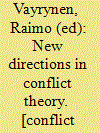

|
|
|
|
|
| Publication |
London;, Sage Pub, 1991.
|
| Description |
viii, 232p.
|
| Standard Number |
0803984352
|
|
|
|
|
|
|
|
|
|
|
|
Copies: C:1/I:0,R:0,Q:0
Circulation
| Accession# | Call# | Current Location | Status | Policy | Location |
| 033603 | 303.6/VAY 033603 | Main | On Shelf | General | |
|
|
|
|
| 5 |
ID:
121828
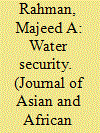

|
|
|
|
|
| Publication |
2013.
|
| Summary/Abstract |
This article examines the transboundary water challenges among riparian states in and around the Nile river basin. The article argues in agreement with the Collier-Hoeffler conflict model (1998) which claims that Africa's natural endowments, such as diamonds, gold, copper, bauxite, and oil, are strong predictors of violent conflict in Africa. This article further posits that these natural economic endowments, such as natural resources and geographical locations which include the Nile river basin, are potential triggers of conflict in the horn of Africa.
|
|
|
|
|
|
|
|
|
|
|
|
|
|
|
|